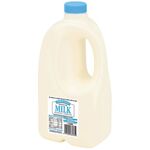Cow & Gate Milk 2L $3 (In-Store Only) @ The Warehouse
Last edited 30/06/2023 - 13:10 by 1 other user
Related Stores
closed Comments

Even Standard price cheaper than others

Yup, been back in nz since jan this year and it’s always been $3 since then, so this post is old news

Good price but always no stock

Try wh new market. They have stock every day (sometimes different expiration date due to overstock)

Not sure how this is a deal per se - this is the same price it has been for ages, and is not a 'special' or anything?

It’s good standard price and cheaper than others

Sure - but not a deal. It might feel like that if you have been choosing to pay a lot more elsewhere, but if so, that is a choice you were making.
Bit like when people breathlessly discover the same thing on 'social media' every few years, and have their 'minds blown'.

I clearly don't buy milk often - saw Red Fat in link and thought it may be a new milk with extra cream and a red lid, but nope just watered down reduced fat

Low or no fat does not mean watered down it just that fat is removed or reduced, no fat milk is great for making Icelandic Skyr , it's a mild tasting creamy yogurt like cheese , , etc , or you can make kefir which likes full cream but you can use low fat milk the probiotic in kefir is more than any other food and it's excellent for healthy and there are white papers ie research which also confirm s

Bombay bazaar , Indian shop at ChristChurch sales at ,2.69 for ,2 litre milk every day , condition you have spend 10 $ at shop it's easy as Indian grocery is reasonable or similar to others .

nice

An actual, current deal is (or was last time I looked) at Fruit World (if I have the name right):
$5.49 for two 2L bottles (no other purchase required as far as I know - please correct me if I am wrong)
No idea if that is still running and if so for how long.

I have never seen green or red at mine. Mainly all dark blue , sometimes light blue. I prefer green top .
BTW, my local fresh choice store often sell milk for $2 for 2 litre and sometimes less when it is a day away from the best before date. GUessing it just gets thrown out when it is after the date.

If you compare the nutritional information on the label with other milk brands all the numbers seem to be less which indicates it probably is watered down a bit.

If they add water don't they have to say that in the ingredient list? You are right though: 250ml Cow & Gate Blue = 7.8g protein (Meadow Fresh Blue & Anchor Blue = 8.3g) and 290mg calcium (Meadow Fresh Blue = 300mg, Anchor Blue = 292mg). Most other stuff is the same. I'd never noticed so thanks for pointing that out.

Today, standardisation means the milk is deconstructed down to the molecular level. Some retentate (fat, protein and solids) is added back to the permeate (white water). This allows factories to standardise both the fat and the protein.
The levels of protein and fat are regulated in the NZ/AU Food Standards. Whole milk must have at least 3.2 per cent fat and 3.0 per cent protein. If you look at your milk bottle, you’ll find your milk has exactly those minimum percentages.
If they use the same process in Engine oil they would proudly call it synthetic oil.

Really interesting thank you. So if the protein is higher in some brands (as it is) it's likely that they have added higher protein retentate to the permeate rather than the lower protein manufacturers (e.g. Goodman Fielder with Cow & Gate) adding water to the "milk"?

@Savey: No, they don't add water to milk it's against the law so what they do is take protein and fat out of the milk and then put it back in at a lower level but no lower than the NZ food standards, so a milk with less body to it has got less fat and protein giving the appearance that has been watered down. For example, a standard dairy farm would produce milk at 4.3% fat and 3.8% protein or higher and at certain times of the year mainly towards the end of the season fat levels are around 6% or higher.

Does it vary across a year at all, or will a given brand always have the same figures on their label (excepting a one-off change that might occur)?

@Alan6984: No that's why they call it standardisation which means fat and protein are taken out of the milk and then put back in at lower levels. They're basically harvesting the fat and the protein out of milk and producing other products.


This is the standard price eh?
https://www.cheapies.nz/tag/cow-gate